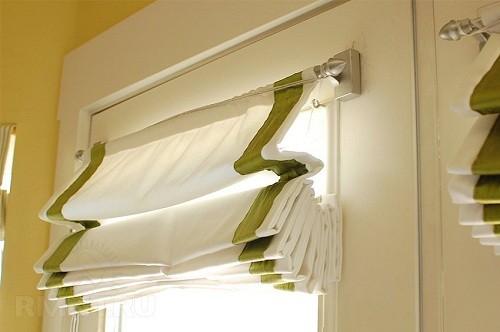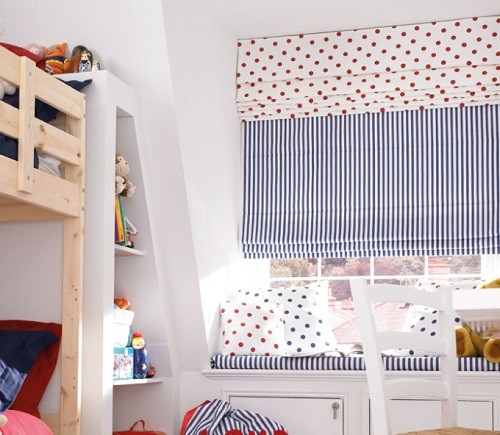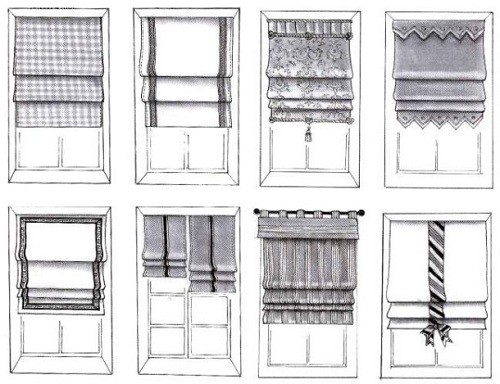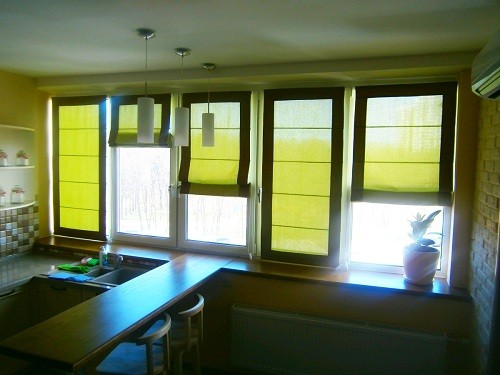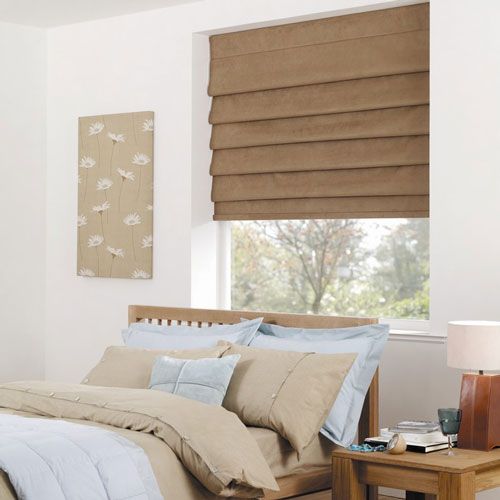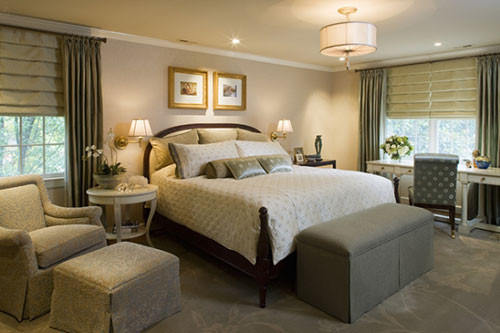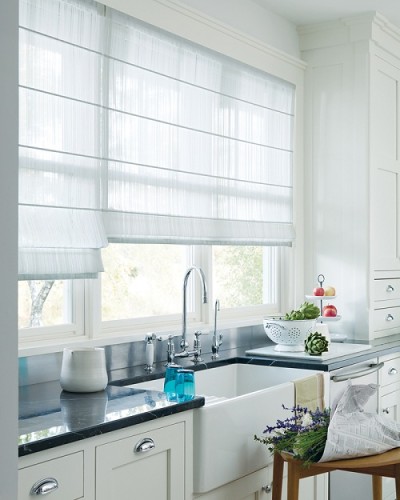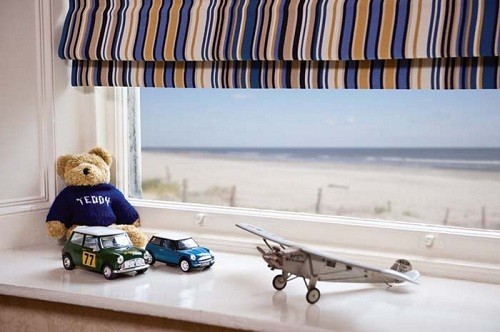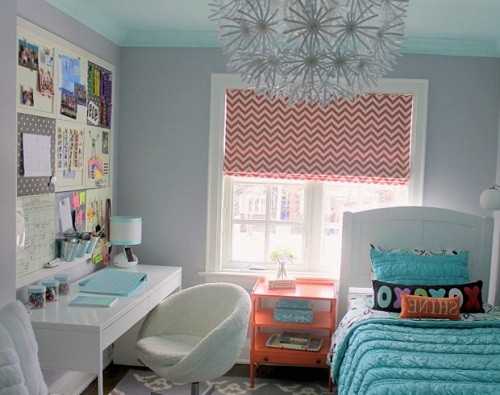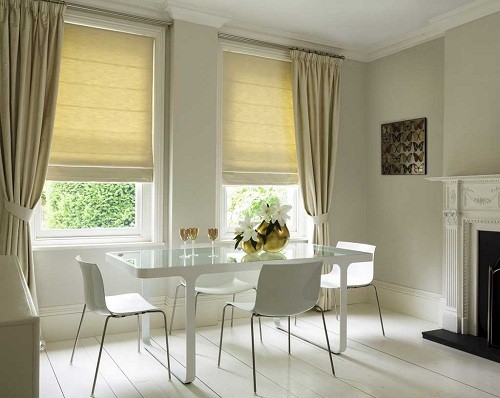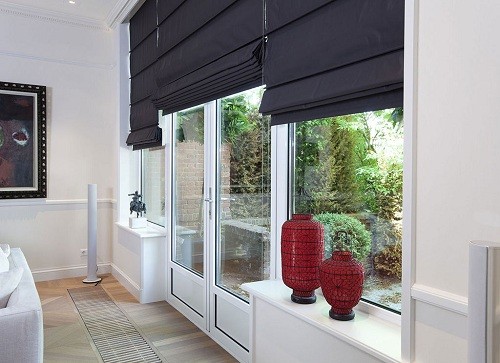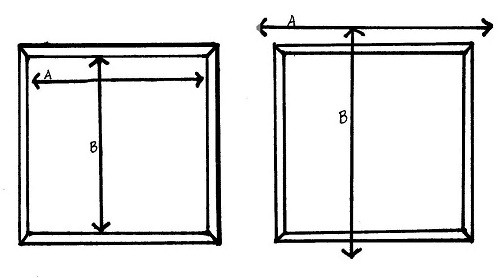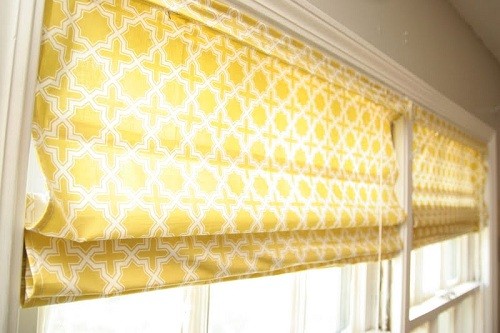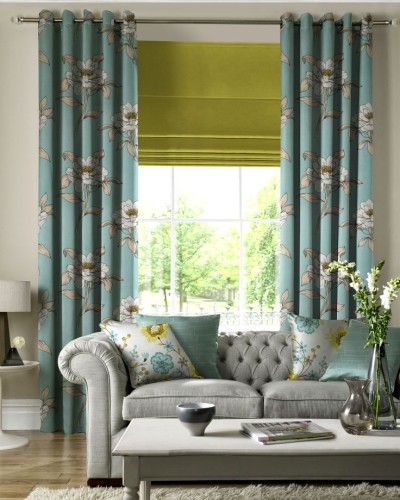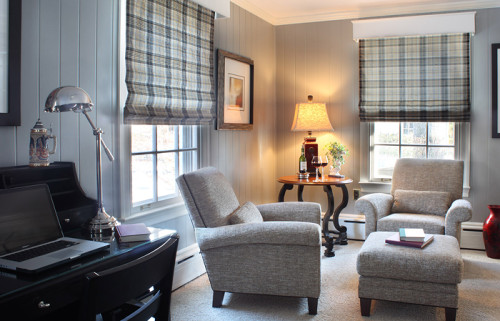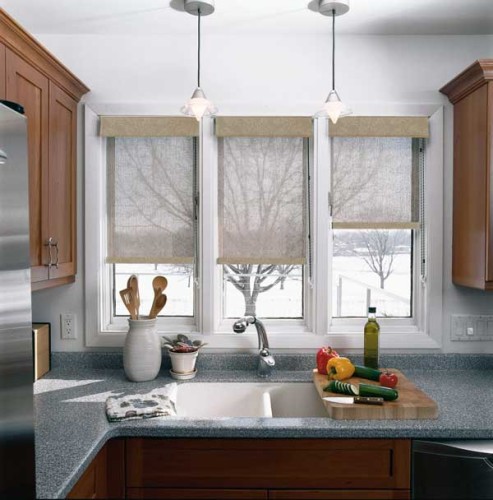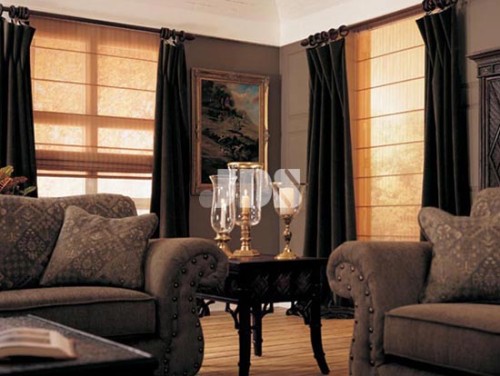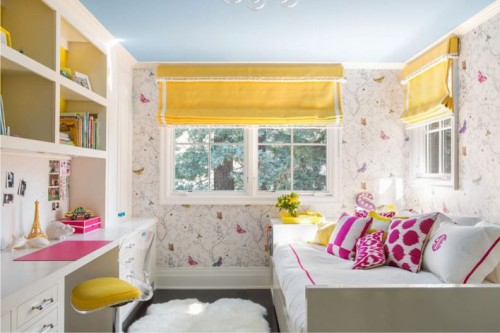
Roman curtains for living room, bedroom, office. Useful advice,Interior items
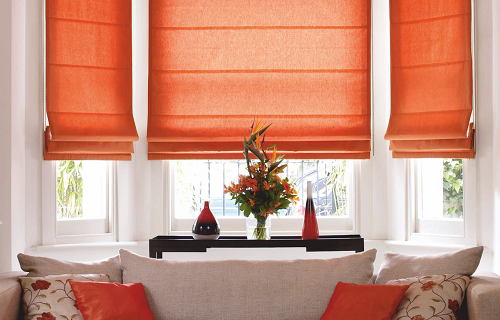
Roman curtains are able to decorate and add any interior. Stylish, laconic, elegant, air - depending on the type of design and selected fabric, they can set the desired mood and emphasize the beauty of the room decoration. Any curtains are not only a tool to protect against the sun and outsiders, but also an important decorative element that serves to create a harmonious visual perception. I first look at the Roman curtains, it may seem that their design is extremely simple, but when you try to sew them inevitably there are complications. In this article, you will learn how to choose the right fabric, sew the Roman curtains with their own hands and concisely entertain them into the interior.
Content
Design features
Roman curtains appeared on the market relatively recently, but immediately attracted attention to their unusual design - light, elegant and practical. They are among the average between conventional tissue curtains and blinds. The daily light passes through the fabric and softly disperses around the room, staining in this or that shade depending on the selected pattern.
Roman curtains on the windows are suitable for absolutely any interior: bedrooms, kitchens, children's and even bathroom. Its design is very simple and is a wooden, plastic or metal cornice that holds a flat rectangular cloth. It, in turn, is permeated with rods that form horizontal folds and turn the matter when you need to open the window. A special cargo is attached to the lower edge of the canvas, which fixes the shape and straightens the curtains. Regulation is carried out using a cord mechanism that raises the cloth to the desired level.
Interesting: The design of modern Roman curtains designers borrowed from the ancient Roman navigators who were manufactured for their vessels light and practical sails from direct feed cuts.
Roman curtains have a lot of advantages compared to classic models. The most important thing is the fact that it takes much less tissue to manufacture, since there is completely no drapery, and the canvas turns out absolutely straight. From this follows the second advantage - the drawing on the fabric is revealed in all its glory and is not distorted by folds. Therefore, if you have a small cut in the farm, a small cutout of a very beautiful fabric, which is not enough to tailor, turn it into the Roman sort. Given that the material should be quite a bit, you can afford indeed expensive and high-quality textiles with exclusive drawings. For details on how to choose a cloth and make measurements, we will tell a little later.
In the meantime, let's summarize the above information and scout at the dignity of the Roman Curtain:
- Compactness - the eaves can be attached not only to the wall or ceiling, but also place in the inner part of the window opening, thus freeing the space on both sides of the window. Of course, in this case, the window slopes must be beautiful and neat, so as not to spoil the overall picture.
- You can adjust the lifting height - convenient control makes it possible to raise the web not completely, but on the desired height, thus controlling the degree of lighting in the room and opening access to the windowsill.
- For Roman curtains it is easy to care for - canvas can be removed at any time from the cornice and wash. Useful advice for those who saved their own time - after washing, immediately hang the canvas in place, without waiting for drying, then they will be smoothed independently under their own weight.
- Aesthetics - you can easily pick up a cloth for sewing curtains for any interior. Moreover, if desired, you can simply change the cloth without reinstalling the entire system.
- Safety - to the bottom of the canvases are sewn cradles that do not allow the curtains to develop from blowing wind. This significantly reduces the risk of fabric ignition, especially if we talk about the kitchen, where the window is located next to the stove.
Types of Roman curtains
You can find many models of Roman curtains, but all of them can be divided into two types depending on the design features: classic and cascade. In the first case, the curtains look like absolutely smooth and even canvases forming horizontal folds when lifting. Externally, such products look very simple, but it is safe to say that they are able to decorate even the most confused and rich interior.
Cascade designs are distinguished by the fact that they are visible to the folds even in the open form - they like a cascade descend down the canvas, creating an elegant drapering. Such models can be found in classic rustic-style interiors or art deco.
However, the main diversity makes no design, but a fabric that is used for sewing. Roman curtains on plastic windows can be made of completely any fabrics, given when choosing their design and interior features. So, for the classic option, fabrics with beautiful patterns or a large-scale pattern are suitable, since it will be good to read on the smooth web. But for cascading, it is best to choose monophonic canvases with different light-permeability.
Roman curtains in the interior
Roman curtains are universal in the sense that they can be used in any interior. So, in the classic, they emphasize the elegance and the rigor of the situation, in Bohemian - will get rid of the claims and persecution, in Highite, the monotonous canvas will be added comfortable, and in Loft - originality. The versatility of the Roman curtain is also in the fact that they are suitable for any room, even for the one where the curtains are in principle inappropriate, for example, for a restroom. Most often, they are used in the interiors in the style of Etnik, Country, Eco, that is, in an approximate style for nature. This can be explained by the simplicity and ease of curtain design. However, if you change the pattern and texture of the canvas, it miraculously fit into any environment.
Roman curtains in the bedroom
A person spends about a third of all his life in a dream, so it is very important that the bedroom is framed the best way. In this case, the tissue for curtains is desirable to choose a dense, but vary the level of lighting to its taste. For example, if you like to sleep, or the work schedule dictates its conditions, and you have to sleep in a bright day of the day, choose a dark light-tight fabric. If you already like the romantic situation and soft lighting, prefer less dense tissue.
Useful advice: To organize a harmonious space and not neglect the overall color palette, leave a little cloth to tailoring covers for decorative pillows or bedspread on the bed. So it is not good way you will create a harmonious interior.
In the bedroom, they look perfectly with the porters, and if necessary, you can fully sharpen the room. You can also meet a decoration method with a cornice for Roman curtains, which makes them more intricate and textured. Another option is a canvas suspended in two rows and managed independently of each other. Such a simple solution is not deprived of sophistication, especially if the curtains are sewn from a tissue with different light-paint ability.
Roman curtains in the living room, office
When designing the living room, you can also use the option with double curtains. One canvas will perform the function of the air curtains, the second is the port. It will be useful to "play" with the color saturation of the curtains, making curtains from the light tissue of pastel tones, and the curtains are made of a dense linse of a saturated shade (you can with a pattern or pattern). Such an option will be perfectly looking at the room with large windows.
As for the design of the working office, it is necessary to focus on conciseness and rigor - you should not distract you from work. In this room, solitude and concentration by weight of gold, so avoid sharp catchy colors, suitable patterns and shiny tissues. Preference to one-photo curtains with a minimum finish or without it without it.
Roman curtains in the kitchen
In the dining room or in the kitchen, the Roman curtains will fit perfectly, since it is often in such premises there is no possibility to hang ordinary curtains. The reasons may be different, but mostly classic "rags" on the windows are the remnant of the past era and look, to put it mildly, unprepacently. In addition, fabric drapes in the floor will collect all the kitchen smells on itself, so it will have to wash it quite often. It is also worth recalling the safety - the curtain of the busting of the wind from the window can attribute to the burning burner, and there will be a fire. With the Roman Curtains, this will never happen.
When choosing a curtain for the kitchen, it is necessary to repel all the same from the functionality and practicality - the fabric should not be a brand, at a minimum absorb smells and easily purge from dust and fat, flex from sunlight. It is for this reason that many designers choose Roman or other rolled curtains, which, according to ease of care and aesthetics, are superior to ordinary drapery and blinds.
Roman curtains in children's
Children's is another room where you need to remember practicality and security. Roman curtains are ideal for such a room not only from these considerations, but also because they can decorate the interior images for children's theme. The classic canvas without drapery is absolutely straight, so you can choose fabric fabric characters or order textile printing in atelier.
In the nursery should reign cleanness, and for Roman curtains it is very easy to care for. To remove dust from them, you can walk along the canvas with a vacuum cleaner, and if serious pollution happened, the wash takes at least a time. In addition, you already know what to dry and iron the cloth is optional.
If the window in the nursery is located near the bedroom zone, do not choose a cloth for sewing the curtains of bright "screaming" shades, otherwise the child will sleep badly. This option is more suitable for the gaming area. Most often the window is located opposite the desktop where the child does lessons. In this case, the rules of choice are exactly the same as for the Cabinet.
Roman curtain manufacturing technology
Roman curtains, in essence, it is just rectangular segments of the fabric with the size of the window opening, which they close. You can make them from an absolutely any piece of matter suitable size, but still there are preferred fabric options. In addition, depending on the selected tissue, they can affect the interior, differ in operational characteristics and complexity of processing.
Fabric selection
For the manufacture of Roman curtains, any fabrics are suitable, whether it is heavy curtain matter or air transparent tulle. But earlier we already said that the design was "spied" from the ancient Romans, which were making sails for high-speed vessels from dense opaque tissue. It should be, for this very reason it is believed that it is best to take natural dense tissue for sewing. This can be explained by practical considerations - rigid tissues are ambulance and kept well.
However, it would be a real crime not to enjoy the widest assortment of the modern textile industry. Thus, in addition to genuine matter, synthetic translucent fabrics can be used from linen, cotton and hemp fiber. They will help hide you from curious eyes, but at the same time will miss the maximum of sunlight. If you set the goal to completely block the light, for example, when designing a bedroom, give preference to the tissue series, the back side of which is covered with a light-tight substance. Not only are they create a dense shadow, they don't completely fade in the sun and protect the inner decoration and furniture from direct sunlight.
If you are going to sew the Roman curtains for the kitchen, take the choice of fabric with special care, because even a very good extract will not save the fabric from fat evaporation and smells. First of all, buy matter with dirt-repellent properties so that it can be cleaned, but it came out as less as possible. Almost all synthetic fabrics have such qualities, but if you really want to give the interior of the naturalness and "naturalness", there are comprehensive and combined flax or cotton matters on sale with the addition of synthetics. Such curtains will look like linen or cotton, but the initial appearance will retain longer. If you are planning to make double curtains, choose dense tissue with a white inland side so that they do not burn out in the sun. Thin aircraft can act as Tulle, such as linen veil or organza.
When choosing, do not forget that the drawing must correspond to the interior stylistry, the color and texture of the furniture. The most versatile in this respect are monophonic tissues, so they can be easily entered into any interior. But if you "pull" on bright floral motifs, fruit images, landscapes or classic cage, make up a room in country style or provence. Miscellaneous genomery, including abstractionism, will be appropriate to look at the avant-garde interior.
Methods of fastening
The main rule of sewing Roman curtains is ideal proportions. If measurements incorrectly, the canvas will not clearly close the window opening. It is also important to correctly determine the flow of matter, based on the attachment method.
How to fix Roman curtains:
- In the window opening - the curtains are located in close proximity to the window glass. Typically, this mount is done for windows with a wide window sill, to use it to the fullest, because even with the unfolded canvase, access is saved. Another case when you can "start" the speed along the glass - installation complete with porters, lambrequins or other structures.
- To the wall - the canvas is fixed along the outside of the opening on the wall, if the window has a window, or when it opens inside the entire height. For this method of fixing the canvas should be 5-10 cm more open from all sides. These allowances will cover slopes and lumeges formed by the window from the window.
Roman Curtains: Manufacturing Instructions
In addition, the ready-made Roman curtains are "solo" or double, each row may consist of one or more canvases. It depends not as much as the dimensions of the window opening, as from the designer idea. If you plan to do a few cloths, for each of them you need to highlight a separate cornice, which increases the cost of ideas. But those who are going to sew the Roman curtains for the first time, one can recommend to make a mono structure from solid canvas first. This will allow you to be in the essence of the work and "fill your hand."
What materials will be needed for work:
- matter for the canvas itself;
- tissue tape with velcer length in the width of the canvas;
- inserted rods 4-5 mm thick and 3 cm long smaller than the width of the web (7-8 pieces);
- plastic rings 10-12 mm for each row, which will pass the lace to control the curtain;
- nylon lace - 3 segments in 2 length and 1 width of the canvas;
- cargo (bar can be bought in a specialized store curtains);
- bar for fastening the structure of 2.5x5 cm long width long;
- carnations, screws.
Instructions for sewing:
- Perform the window opening measurements, and then add 5-7 cm on the sides and 10-15 cm below and on top. As a rule, there should be approximately 20% of the entire height of the canvas in height.
- Before starting to board, draw the fabric, turning it for 3-5 minutes in warm water, drying and turning. So you can exclude the risk of shrinkage of matter during the sewing and not mistaken in the calculations.
- In height of the opening and the length of the curtains, calculate the number of folds and the distance between them (for a cascading type of construction). To find the optimal folding step, use the table below:
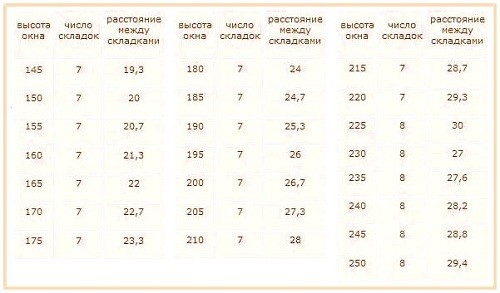
The secret of manufacturing Roman curtains is the correct calculation of each fold: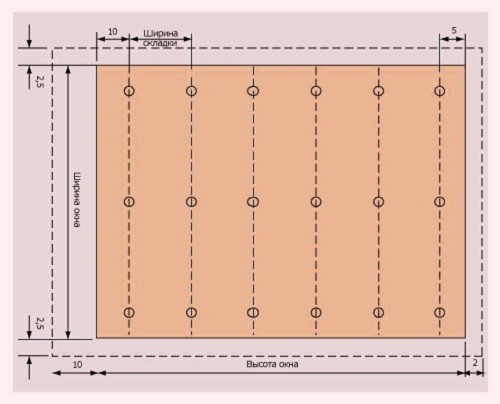
- With the outfit of the fabric, make the layout of the naval lines and folds, mark the points of installation of the rings. To get beautiful drapery, folds should be located on an equal distance and be the same in width.
- Process the sidewalls of the canvas double bending.
- Take the wooden bar and come to it with a velcro with a furniture stapler or small carnations. On this velcro and will keep a cloth, and it will be possible to quickly remove it at any time.
- Treat the top edge of the canvase and enter the second side of the velcro.
- Barberry-eaves if necessary, cover the paint of suitable color. Instead of a conventional cornice tree, you can use a lambined bar with velcro (it is sold complete with brackets for the ceiling).
- Make a chandency at the bottom of the web and create a width sceress so that you can insert a weight loss. You can buy a special bar-cargo, and you can save and take a flat aluminum profile in a construction store with a length of 1-2 cm less than a cornice. If you work with a transparent or light cloth, paint the weight in tone with matter.
- In the involve of the canvas, insert the finishing cut and in the resulting pockets insert the prepared rods, and then close the holes on the one hand. The edges of the rods should be covered so as not to cling the fabric and keep tightened on it. Ideally, it is recommended to take plastic products that are sold in stores of textiles and curtains. Corset inserts are also suitable, but they will be needed to pre-straighten, as they are sold marked and stored in a roll. To do this, cut them on the required number of parts of a slightly more required, warm the iron with a ferry through several layers of gauze, and until they cooled, put a couple of days under the press.
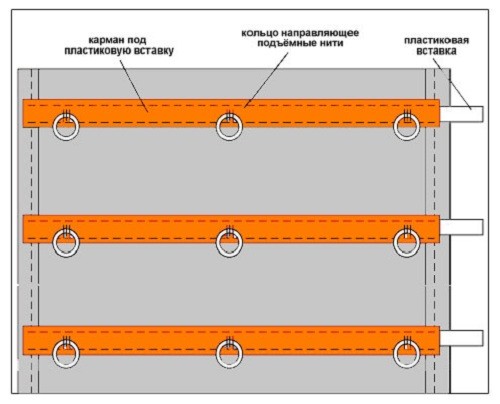
- Make marking for the rings and sushach them to the canvas manually, and to the bar, come with nails (for fixing the lifting mechanism). Rings must stand strictly symmetrically with respect to the central part of the web, and the most extreme must be fixed not closer than 5 cm from the edges.
- Stick the cloth on the velcro and fix the cord fastener on the window frame. To secure the sound, wrap the cord around it.
- Start in the line of the cord in the ring from the bottom-up. On the very first ring, tie a node and drop on it with transparent glue for reliability.
- To inhale the cord in all rings to the top of the canvas, then do the same with all rows. Out all the cords on one side, pull to evenly distribute the folds in width and tie them for a while with ribps.
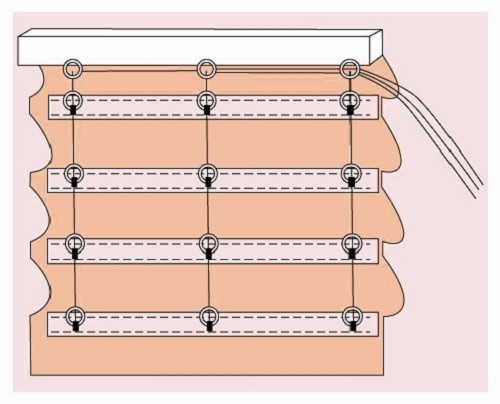
- Attach the bar above the window or on the frame, unleash the ribbons and lower the fabric. Adjust the tension of the shoelaces, collect them together and tie into the knot for the last ring. After tightening them through the handle, which you will lift the cloth, step up 50 cm from this node and make the second. Cut the tips of the cords just below the second nodule and enjoy the result of your works!
We hope this detailed instruction on how to sew a Roman sort will help you add a "highlight" in the interior of each room.
Alternative fashion sewing:




